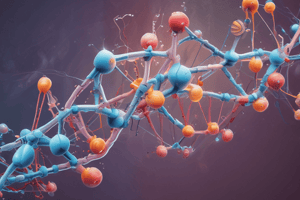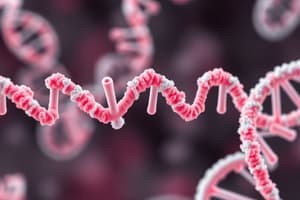Podcast
Questions and Answers
What is the mechanism of action of sulfonamides?
What is the mechanism of action of sulfonamides?
- They inhibit DNA synthesis directly.
- They convert folic acid into folinic acid.
- They compete with PABA for the enzyme dihydrofolate reductase.
- They inhibit dihydropteroate synthetase. (correct)
What is the therapeutic use of sulfasalazine?
What is the therapeutic use of sulfasalazine?
- Burns
- Malaria
- Eye infection
- Ulcerative colitis (correct)
What is the adverse effect of sulfonamides in patients with G6PD deficiency?
What is the adverse effect of sulfonamides in patients with G6PD deficiency?
- Hypersensitivity reactions
- Kernicterus
- Hemopoietic disturbances (correct)
- Crystalluria and nephrotoxicity
What is the enzyme inhibited by trimethoprim?
What is the enzyme inhibited by trimethoprim?
What is the combined form of trimethoprim and sulfamethoxazole?
What is the combined form of trimethoprim and sulfamethoxazole?
What is the adverse effect of trimethoprim that can be avoided by folinic acid administration?
What is the adverse effect of trimethoprim that can be avoided by folinic acid administration?
What is the reason for crystalluria and nephrotoxicity caused by sulfonamides?
What is the reason for crystalluria and nephrotoxicity caused by sulfonamides?
What is the adverse effect of sulfonamides in premature infants?
What is the adverse effect of sulfonamides in premature infants?
What is the effect of sulfonamides on oral hypoglycemic and anticoagulants?
What is the effect of sulfonamides on oral hypoglycemic and anticoagulants?
What is the structural analogue of PABA?
What is the structural analogue of PABA?
Flashcards are hidden until you start studying
Study Notes
Inhibitors of Nucleic Acid Synthesis
- Rifamycin: inhibits RNA synthesis and is used to treat tuberculosis
- Quinolones and fluoroquinolones:
- Ciprofloxacin: inhibits DNA gyrase, used to treat urinary tract infections
- Mechanism of action: inhibits DNA gyrase enzyme, which unwinds double-stranded DNA, leading to inhibition of DNA replication
- Therapeutic uses:
- Typhoid fever
- Urinary tract infections (Gram-negative bacilli) and prostatitis
- Gonorrhea (ofloxacin single dose)
- Respiratory tract infections not responding to β-lactam antibiotics
- Bone and soft tissue infections
- Adverse effects and contraindications:
- CNS symptoms (headache, dizziness, phototoxicity)
- Nephrotoxicity
- Arthropathy in children less than 18 years
- Inhibits liver microsomal enzymes, leading to drug interactions (increased level of theophylline and warfarin)
Rifampicin
- Mechanism of action: inhibits DNA-dependent RNA polymerase in mycobacteria, leading to inhibition of RNA synthesis
- Therapeutic uses:
- Potent bactericidal drug against mycobacteria tuberculosis at all sites
- Treatment of leprosy
- Prophylaxis of meningitis
- Oxacillin-resistant Staph aureus
- Adverse effects:
- Skin rash, fever, and gastrointestinal upset
- Liver damage and jaundice
- Enzyme induction, leading to serious drug interactions
Mechanisms of Antimicrobial Action
- Classification based on mechanisms of antimicrobial action
- Bacteria have their own enzymes for:
- Cell wall formation
- Protein synthesis
- DNA replication
- RNA synthesis
- Synthesis of essential metabolites
- Viruses use host enzymes inside host cells
- Fungi and protozoa have their own eukaryotic enzymes
- The more similar the pathogen and host enzymes, the more side effects the antimicrobials will have
Antibacterial Antibiotics: Inhibitors of Cell Wall Synthesis
Penicillins
- Mechanism of action: bactericidal by inhibiting transpeptidation (last step in bacterial cell wall synthesis) through binding to penicillin-binding proteins (PBP)
- β-Lactamase is an enzyme secreted by some bacteria, leading to inactivation of β-lactam antibiotics (resistance developed)
- Preparations of penicillins:
- Natural penicillins (e.g. penicillin G and penicillin V)
- Anti-staph penicillins (e.g. oxacillin, cloxacillin, and flucloxacillin)
- Extended-spectrum penicillins (e.g. ampicillin and amoxicillin)
- Antipseudomonal penicillins (e.g. ticarcillin and carbenicillin)
- Therapeutic uses:
- Streptococcal infections (e.g. acute tonsillitis, wound sepsis, puerperal sepsis, and subacute bacterial endocarditis)
- Staphylococcal infections
- Pneumococcal infections
- An influenzae-like syndrome (malaise, headache, and fever)
- Red discoloration of the urine, tears, and sputum
- Resistance rapid due to modification
Competitive Inhibitors: Sulfonamides (Sulfa drugs)
- Inhibit folic acid synthesis
- Broad spectrum
- Mechanism of action: sulfonamides are structural analogues of PABA, competing with it for the enzyme dihydropteroate synthetase, leading to inhibition of folic acid synthesis with consequent inhibition of DNA and RNA synthesis
- Therapeutic uses:
- Eye infection (topical sulfacetamide)
- Burns (topical silver sulfadiazine)
- Ulcerative colitis (sulfasalazine)
- Malaria (sulfadoxine combined with pyrimethamine)
- Adverse effects:
- Hypersensitivity reactions
- Crystalluria and nephrotoxicity due to insoluble metabolite precipitation and can be avoided by increased fluid intake and alkalinization of urine
- Hemopoietic disturbances (e.g. granulocytopenia, thrombocytopenia, and hemolytic anemia in patients with G6PD deficiency)
- Kernicterus as sulfonamides displace bilirubin from plasma protein → cross BBB in premature infants → CNS depression
- Drug interaction as it increases plasma level of oral hypoglycemic and anticoagulants due to plasma protein displacement
Trimethoprim
- Mechanism of action: inhibits dihydrofolate reductase, which converts folic acid into folinic acid (tetrahydrofolic acid), essential for DNA synthesis
- Combined with sulfamethoxazole to form co-trimoxazole
- Adverse effects:
- Megaloblastic anemia due to folate deficiency, avoided by folinic acid administration
- Granulocytopenia and leucopenia
Studying That Suits You
Use AI to generate personalized quizzes and flashcards to suit your learning preferences.




